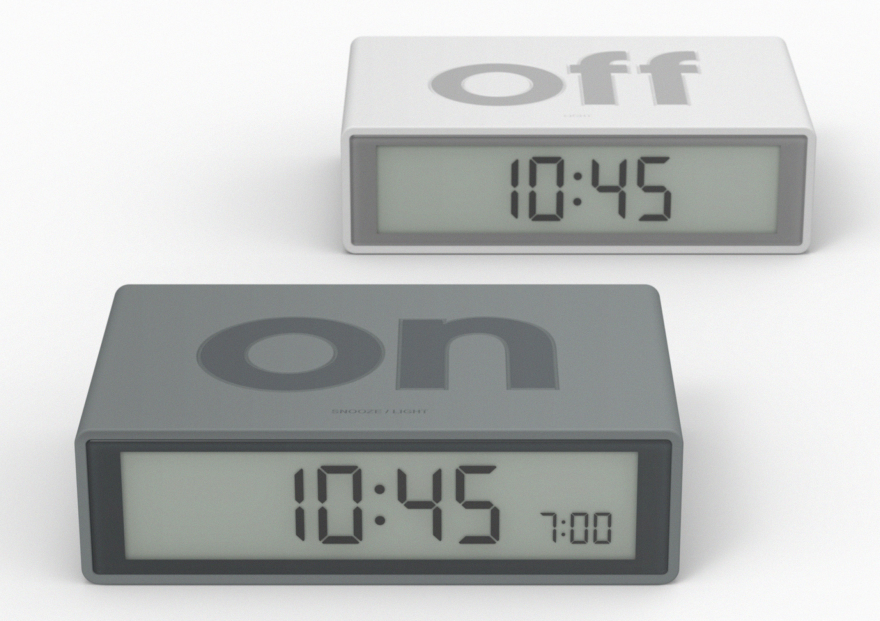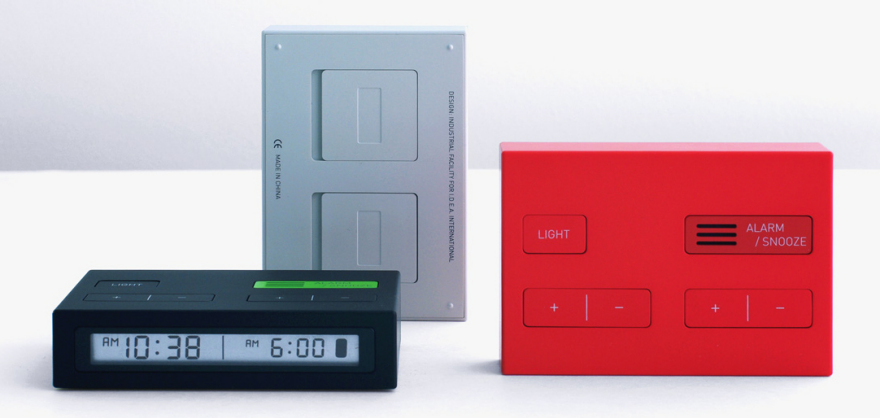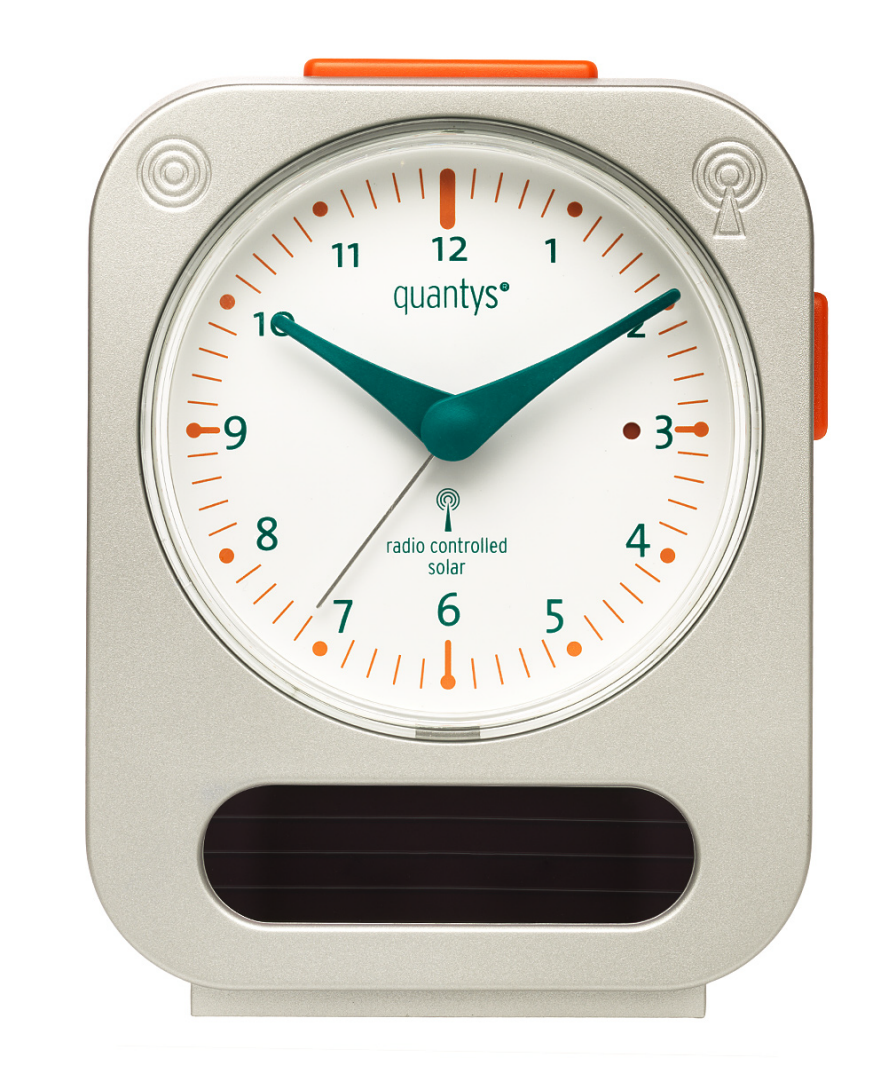
11 Alarm Clocks for Starting the Day Right
Many people are happy to use their smartphones as their alarm clocks, but that won't work for everyone. Some users don't have smartphones—or are minimally tech-proficient and only know how to use them for limited purposes. Others choose to follow the advice of sleep researchers and feng shui consultants and keep all screens out of the bedroom. And others simply find a physical alarm clock easier to deal with when waking up than a smartphone.
 Enter a caption (optional)
Enter a caption (optional)If you're an industrial designer working on an alarm clock, remember that users care about ease of use, the sounds used to wake them up, the display lighting during the night, and of course the reliability. The Lexon FLIP alarm clock, designed by Adrian and Jeremy Wright, certainly keeps things simple; the user just flips the phone over to turn it on and off. This could be useful for a quick alarm silencing when one spouse needs to wake earlier than the other.
 Enter a caption (optional)
Enter a caption (optional)The user can choose a 12-hour or a 24-hour display, which is a nice feature. The backlighting only comes on when the user picks up the clock, and turns off quickly. This is a problem for some users, but those who don't want a clock light on all night will be pleased. Some users also noted that this clock tends to run through batteries quite quickly. And it doesn't have a low-battery indicator, as some other alarm clocks do.
 Enter a caption (optional)
Enter a caption (optional)Some users need a travel alarm clock—and designers have addressed this need with small, durable alarm clocks, often with added features. The Jetlag clock, designed by Industrial Facility for IDEA Japan, was designed specifically for ease of use; no manual is needed. It has one display for the current time and one for the alarm. However, a couple of users have said the alarm sound is too low, so it may not work for anyone but a light sleeper. (Even if someone prefers a quieter alarm so as not to wake a sleeping spouse, it would be better to have an adjustable volume that could go louder when needed.)
 Enter a caption (optional)
Enter a caption (optional)The Braun reflex control travel alarm clock has a motion-activated snooze function. It also has a flip-down lip that protects the clock face while traveling; the interior of the lid has a world time zone map. The silent quartz movement is a feature that would be appreciated on any alarm clock.
 Enter a caption (optional)
Enter a caption (optional)Of course, it's not just travel alarms that have novel designs. The Pick-me-up alarm clock from Thomas Bai Designs lights up the clock face (for five seconds) and activates the snooze function when it's picked up, so users don't need to find the snooze or the off button. (As with the FLIP, this could be useful for spouses waking at different times.) However, unlike the Braun, some users said that this clock is too noisy—a common problem with battery-powered analog clocks. (I had to give away a different alarm clock for just this reason.)
 Enter a caption (optional)
Enter a caption (optional)For users who'd like to wake up to a gentler sound than a buzzing alarm, there's this alarm clock from Now & Zen, which uses a chime. It also doubles as a countdown timer or an interval repeating timer. This alarm clock is targeted at those who meditate and those who practice yoga or various types of bodywork, but it certainly isn't limited to them; I used an analog version of this clock for years, and enjoyed waking to the chime.
 Enter a caption (optional)
Enter a caption (optional)The Timex Simple Set Direct Entry Alarm Clock is notable for just how easy it is to set the time and the alarm; users tend to purchase it for children or the elderly. However, one user noted that the alarm off button isn't that easy to reach; it would be easy to hit the wrong button. And, once more, some users have said the alarm is too soft, even on the loudest setting.
 Enter a caption (optional)
Enter a caption (optional)I have mixed reactions to this TimeSmart self-setting alarm clock from Brookstone. On the one hand, with those big buttons (one for each of the two alarms), it sure is easy for the user to see if the alarm is set, and to turn it off. (There's a large snooze bar between the two buttons.) It has a crescendo alarm, getting louder over time, which helps ensure that heavier sleepers (or those living in noisy city environments) wake up without being too startled. Users can set the brightness of the display; there are five settings, with one of them being "off." On the other hand, users choose the brightness setting by pressing on the snooze bar—not exactly intuitive.
Another concern is the whole "self-setting" thing. The clock is factory set to be correct for the Eastern time zone, although you can change the setting to use any other U.S. time zone. But this clock is not radio-controlled, as the user might assume; it's just using data stored internally. (It has a five-year battery.) A number of users have mentioned problems with time accuracy—the single most important thing for an alarm clock.
 Enter a caption (optional)
Enter a caption (optional)This alarm clock from Quantys is radio controlled; it's also solar powered. With one charge from some hours in the sun, the clock will run for a year; that's going to appeal to the environmentally focused user, and any user who gets tired of replacing batteries. There's another version that's a combination alarm clock and smoke alarm. The red dot you see by the number 3 is the indicator that the alarm is on.
 Enter a caption (optional)
Enter a caption (optional)The Philips Wake-Up Light Alarm Clock simulates a sunrise; the light gradually increases for 30 minutes. After that, there's a beep at the user's set wake-up time, although many users will be awake before then. There's also a snooze function.
Another model of wake-up light from Phillips has a choice of three sounds: morning birds, wind chimes or that beep. Some users really miss not having that choice in this model.
Philips claims that 92 percent of users agree that this alarm makes it easier to get out of bed. However, it may not work for users who take naps during the day, or any users (shift workers, etc.) who need to wake during broad daylight; it’s more suited to dark winter mornings. Also, this is not the alarm for anyone sharing a bedroom with someone who needs to wake up later, since it works over time and will light the room rather than being an alarm the user can have close at hand and shut off quickly.
 Enter a caption (optional)
Enter a caption (optional)The Sound Rise wireless speaker and alarm clock from Soundfreaq was designed for music lovers. Users can choose to wake to a preset radio station or the music on any Bluetooth device they've paired to it. As one user said: "I select the album I want to hear on Spotify, pause play on my phone, and voila, that is what I wake to. If I forget to do that, it plays random selections from music stored on my phone." And if the Sound Rise has trouble pairing, it will use its built-in chime instead.
The Sound Rise also has a USB port that can be used to charge devices such as smartphones and tablets. Screen brightness can be adjusted, and turned off entirely for those who prefer to have no display at night. There are dual alarms with weekday/weekend settings.
The Sound Rise is designed for a nightstand, keeping the footprint as small as possible and going vertical to provide space for the speaker components.
 Enter a caption (optional)
Enter a caption (optional)Some alarm clock designs are created specifically for those who tend to turn off other ones and oversleep. This version of the Ramos alarm clock, which is still in development, is intended for that type of user.
The Ramos Smart is a remotely deactivated alarm clock; it's connected to a smartphone app and a Bluetooth beacon. It forces a user to get out of bed because it will only turn off when the user's smartphone is brought close to the beacon, which should be placed well away from the bed—some place the user wants to go after waking up, such as next to the coffee maker. (Ramos does have a snooze function, but it can only be used a limited number of times.)
-
o1Favorite This
-
Q2Comment
K
{Welcome
Create a Core77 Account
Already have an account? Sign In
By creating a Core77 account you confirm that you accept the Terms of Use
K
Reset Password
Please enter your email and we will send an email to reset your password.

Comments
i'll regret giving this one away, but call me when someone designs a clock with mechanical spider legs that runs around the room squawking for a few laps, then buggers off down the hall and makes sure you're wide awake and up and 35 feet away from your bed before you can catch it and shut it off. i'd pay anything.
i forgot: it kicks you in the head with it's clock-leg before it runs out of the bedroom. optional blast of insect repellant for the non-morning people.